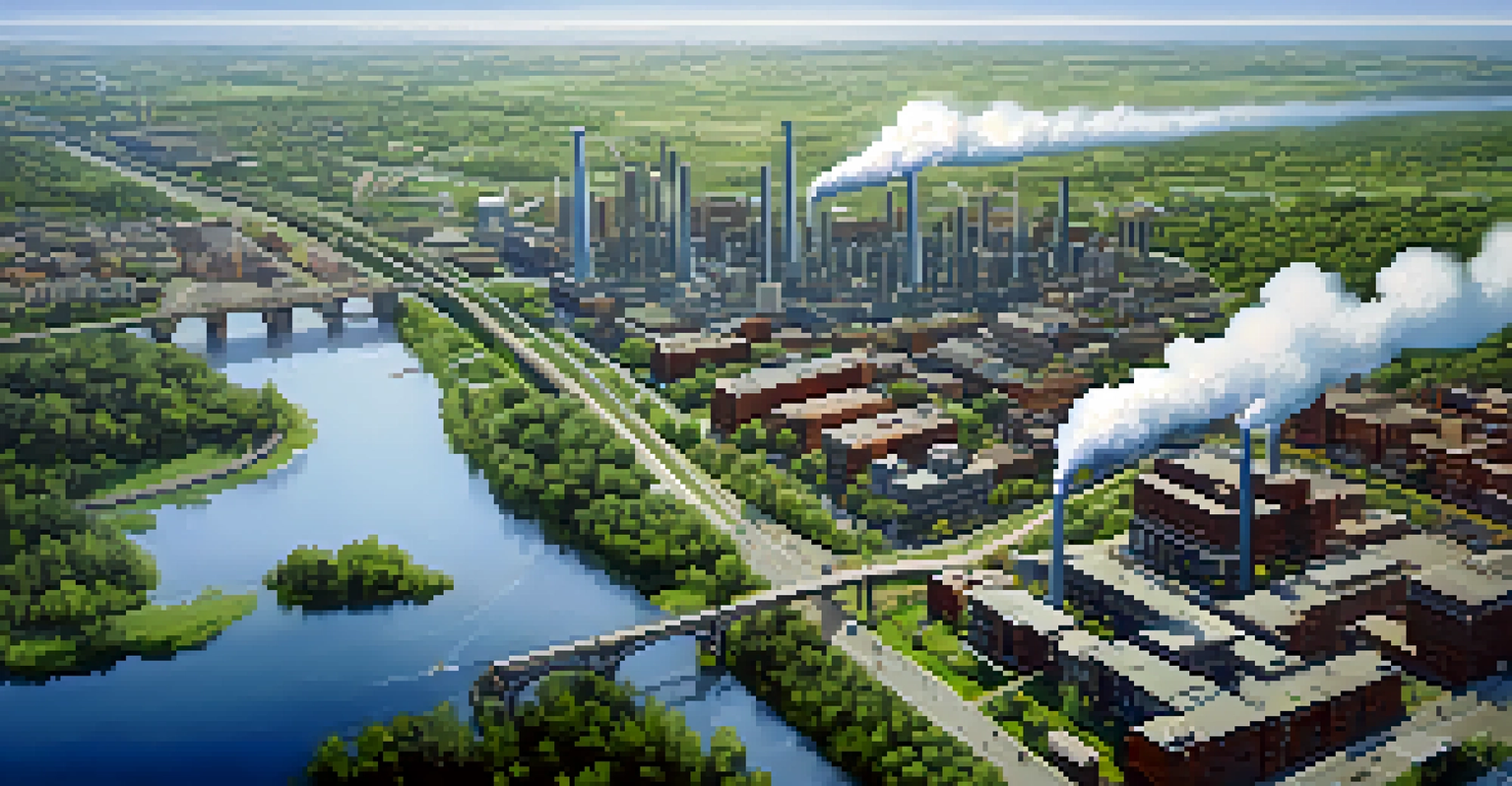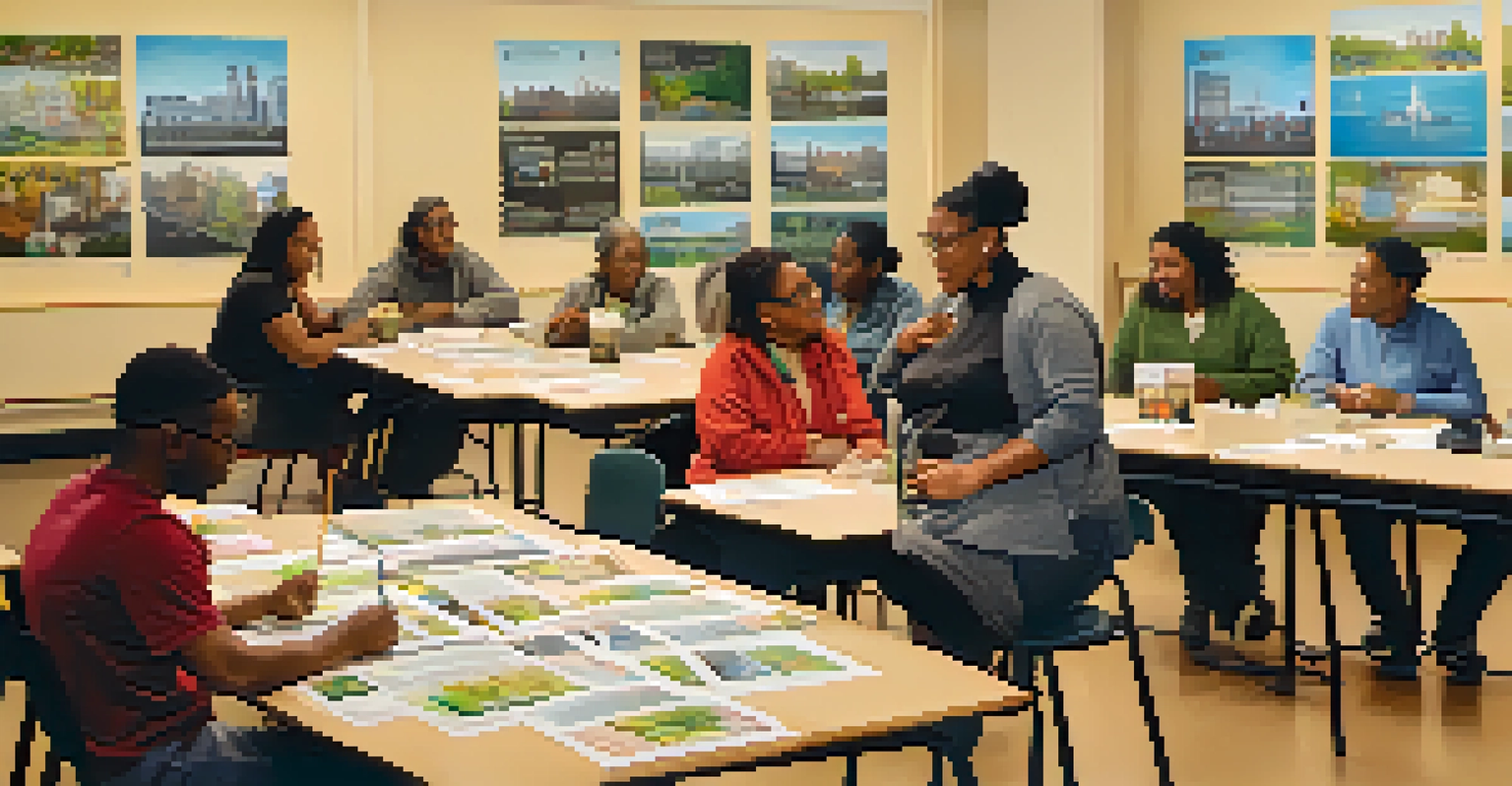Air Quality Concerns: The Impact of Newark's Urbanization

Understanding Urbanization and Its Challenges
Urbanization refers to the increasing number of people living in urban areas, which significantly alters the landscape and environment. In Newark, this shift has led to the development of infrastructure, housing, and businesses at an accelerated pace. While urban growth can bring economic opportunities, it often comes at a cost, particularly concerning air quality.
The greatest threat to our planet is the belief that someone else will save it.
As more buildings and roads are constructed, natural green spaces are often sacrificed. These green spaces play a crucial role in filtering pollutants and providing clean air. Without them, cities like Newark face an uphill battle in maintaining a healthy environment for their residents.
Further complicating matters, urbanization often leads to increased vehicle traffic and industrial activities, both of which emit harmful pollutants. This creates a complex web of challenges that city planners and residents must navigate to ensure a healthier urban future.
Pollutants and Their Sources in Newark
Newark's air quality is mainly affected by pollutants such as particulate matter (PM), nitrogen dioxide (NO2), and sulfur dioxide (SO2). These substances often stem from vehicles, industrial emissions, and construction activities. For instance, heavy traffic on major roads contributes significantly to the levels of NO2, which can have harmful effects on respiratory health.

Additionally, industrial facilities in the area can release a variety of toxic substances into the air. These emissions not only contribute to poor air quality but also pose long-term health risks to the community. Local residents living near these facilities are particularly vulnerable to the adverse effects.
Urbanization Affects Air Quality
The rapid urban growth in Newark leads to increased pollution and degradation of natural green spaces, which are vital for maintaining clean air.
It's essential to recognize that while some pollutants are regulated, others may go unchecked, particularly in rapidly developing urban areas. This underscores the importance of monitoring air quality and implementing stricter regulations to protect public health.
Health Impacts of Poor Air Quality
The health implications of poor air quality are significant and far-reaching. Short-term exposure to pollutants can lead to respiratory issues, headaches, and fatigue, while long-term exposure can result in chronic conditions such as asthma and heart disease. Vulnerable populations, including children and the elderly, are especially at risk.
We won't have a society if we destroy the environment.
In Newark, studies have shown a correlation between high pollution levels and increased hospital admissions for respiratory illnesses. This is a worrying trend that highlights the urgent need for action to improve air quality. Community health initiatives can play a vital role in raising awareness and providing support for those affected.
Moreover, the social determinants of health, such as income and access to healthcare, can exacerbate the effects of air pollution. Lower-income neighborhoods often bear the brunt of industrial pollution, leading to a cycle of health disparities that must be addressed for a healthier community.
Community Awareness and Engagement
Raising awareness about air quality issues is crucial for empowering communities to take action. Local organizations and community groups in Newark are actively working to educate residents on the importance of clean air and the steps they can take to protect themselves. Workshops, informational campaigns, and community meetings are effective ways to foster engagement.
Additionally, residents can participate in citizen science projects that monitor air quality. By collecting data on pollution levels, community members can contribute valuable information that helps to identify problem areas and advocate for change. This grassroots approach not only empowers individuals but also builds a stronger sense of community.
Health Risks from Pollution
Poor air quality in Newark has significant health implications, particularly for vulnerable populations, increasing the incidence of respiratory illnesses.
Engaging the community in discussions about air quality can also lead to partnerships with local government and businesses. Collaborative efforts can pave the way for policies and initiatives that prioritize environmental health and sustainability.
Government Policies and Regulations
Government policies play a pivotal role in addressing air quality concerns in urban areas. In Newark, various regulations aim to limit emissions from vehicles and industries, as well as promote cleaner technologies. These initiatives are essential for reducing pollution levels and improving public health.
The Clean Air Act is an example of federal legislation that sets standards for air quality and emissions. Local governments can leverage these regulations to implement stricter measures that address specific pollution sources in their communities. However, effective enforcement and community involvement are crucial for these policies to succeed.
Moreover, innovative policies such as green building incentives and urban greening initiatives can help mitigate the impacts of urbanization. By encouraging the development of green spaces and sustainable infrastructure, Newark can work towards a healthier and more livable environment.
The Role of Technology in Air Quality Monitoring
Technology has become an invaluable tool in monitoring and improving air quality. In Newark, air quality sensors and monitoring stations provide real-time data on pollution levels, helping residents stay informed. This information is vital for understanding when air quality is poor and for taking necessary precautions.
Moreover, advancements in data analysis and visualization can help identify pollution trends and sources. By leveraging this data, city planners can make informed decisions about where to focus their efforts in reducing emissions and improving air quality. These technological tools empower communities to advocate for cleaner air.
Community Engagement is Key
Engaging Newark residents in air quality monitoring and advocacy initiatives empowers them to take action for a cleaner environment.
Additionally, mobile apps and online platforms can help residents report pollution sources and access air quality information easily. This connectivity fosters a proactive approach to air quality management, engaging citizens in the fight for cleaner air.
Future Directions for Newark's Air Quality
Looking ahead, Newark faces both challenges and opportunities in its quest for better air quality. Urbanization will continue, but with strategic planning and community involvement, it can be managed more sustainably. Prioritizing green spaces, promoting public transportation, and investing in clean energy are essential steps for the future.
Furthermore, collaboration between government, businesses, and residents can lead to innovative solutions that enhance air quality. For example, initiatives like tree planting campaigns can help absorb pollutants while creating a more pleasant urban environment. Involving the community in these efforts fosters a sense of ownership and responsibility.

Ultimately, improving air quality in Newark requires a holistic approach that combines technology, policy, and community engagement. By working together, residents and leaders can create a healthier, more sustainable city for generations to come.